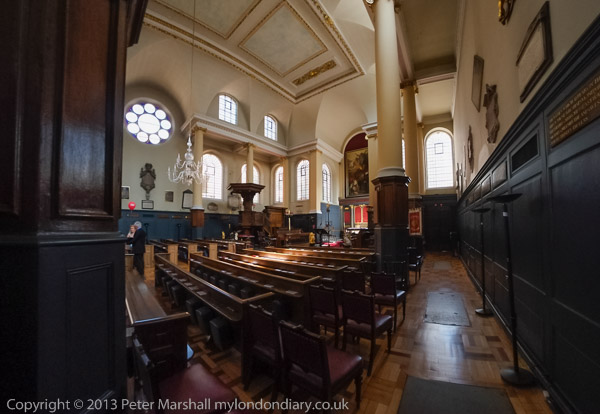
Every May my wife takes part in a sponsored walk, and as well as sponsoring here I sometimes walk around with her (and usually a few others she has persuaded to take part), as the walk is a church crawl in the City of London. It’s pleasantly deserted on a Sunday and the selection of churches at which she has to get her walk card signed and stamped varies enough each year to keep the walk interesting.
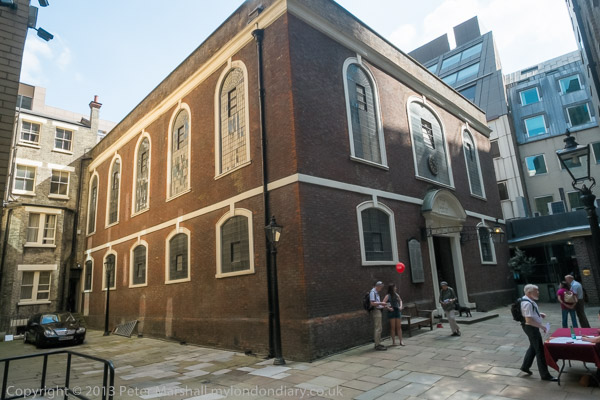
Of course a lot of the city churches are open much of the time to visitors in any case, but there are usually a few places on the walk which Christian Aid has persuaded to open specially for the event. Mostly they are Anglican churches, but each year there are a few exceptions and these are often of particular interest. This year we went into Bevis Marks Synagogue which is an interesting place to visit (and I’ve visited once before) but unfortunately photography inside is not allowed. But everywhere else we were free to take pictures.
Most of the City churches were designed shortly after the Great Fire of London in 1666 by Christopher Wren, but the fact that the plots of land on which they are were of differing shapes and sizes gives them some individuality. Some have suffered more at the hands of restorers than others, and some were severely damaged by bombing in World War II, but overall they are a remarkable collection. Probably my favourite as a building is not by Wren but by Hawksmoor.
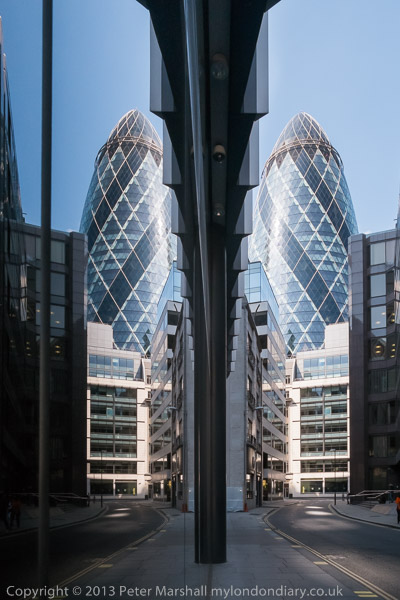
And as well as the churches there were also the walks between them. The city streets we walked along were all familiar, though its a while since I’ve worked there on a Sunday and had the place so empty. I took the opportunity to take a few pictures in between the churches as well, including the one above of seeing a double Gherkin.
Taking pictures when out with others is often a problem and you often have to rush what you are doing and then run to catch up with the rest of the group. But I was really going to keep Linda company (and make sure she didn’t get lost) rather than take pictures.
I was just going to take the Fuji X Pro1 and a trio of lenses – the 18-55mm, the 14mm and the 8.5mm Sanyang semi-fisheye. I could have managed without a camera bag, with one lens in each of my jacket side pockets and the third on the camera around my neck. Of course I’d need at least one spare battery, but that could easily tuck away in one of my inside pockets. But in the end I decided to take a small bag so I could also easily carry a bottle of water and a book to read on the journey. And since I was carrying a bag I might as well also take a second body, the Fuji XE-1
I suffered from a few problems using the Fujis. I was already aware that although the 14mm Fuji lens is superb, and it’s a very nice idea to be able to change from auto to manual focus by a push/pull on the focus ring, it is all to easy to do by accident. And while the signs are pretty obvious when you take pictures, it’s also easy not to notice them. I think I’d like it to be just a little harder to make the change.
The 14mm also has an ‘A’ setting on the aperture ring. It works well, enabling you to work in shutter priority or program mode, depending on whether you set a discrete shutter speed or ‘A’ on the camera shutter speed dial. But what it lacks is some way of locking it to A, or a least a rather firm detent. It is ridiculously easy to accidentally move away from that position and find you are working at f22. And f22 is a setting you would be better without on any such lens, with its ridiculously small physical aperture cutting performance by diffraction.
Most cameras I use need little bits of black tape on them to prevent me making unwelcome accidental changes to settings. But the aperture ring is too vital a control for this to be viable.
Doubtless I’ll get used to these things in time, and remember to check for the obvious warning signs. But one thing that happened was more worrying. On the way home I turned the cameras on to look through the pictures. No problems with the X-Pro1, but with the X-E1 all I got was a message telling me the card was empty and did I want to format it? I didn’t.
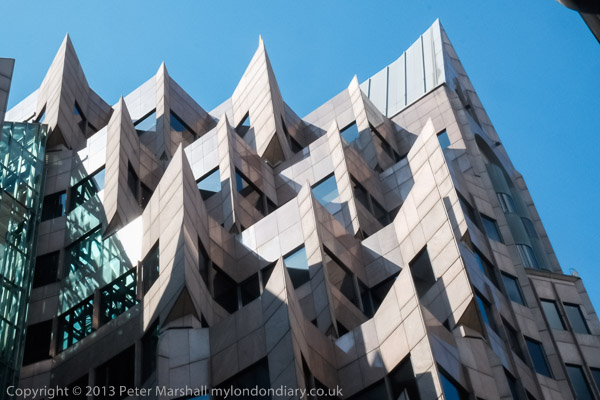
At home I put the card into my computer – which found nothing on it. My copy of Sandisk Rescue Pro which once came free with some Sandisk cards (it now needs an annual subscription) was more successful, and recovered around 600 files it claimed were TIFF files. Unfortunately no software for reading TIFF files agreed, but by renaming them to .RAF files Adobe Bridge gave a fleeting view of the thumbnails before only showing them as black rectangles – though it could read the metadata. By using ‘IJFR‘ I managed to recover the 1920×1280 preview jpgs but found no way to get the larger RAW images I had taken. Better than nothing, but hardly great. I tried various other file rescue programs, but nothing else worked at all, or wanted me to pay to recover the files – without any guarantee it could actually do so. Worst of all were those programs that pretended to be free, scanned the disk and found some entries and then told you to pay up to recover them.
Some of the jpeg images were fine – like the architectural image above, but others where the lighting was rather difficult or the auto-exposure had been rather out were trickier.
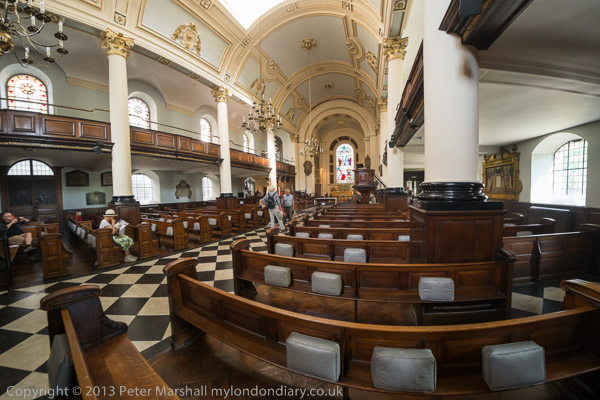
Inside the churches, the Samyang 8.5mm was very useful, both with and without the partial correction of Fisheye-Hemi. (I’ve recently had to buy a new 64bit version of this plugin to use with Photoshop CC 2014.) They really need to update the software to work with the Samyang’s unique projection, though it does still improve many images – such as that above.
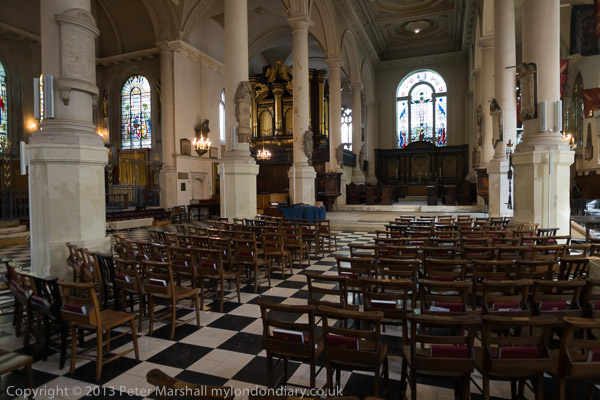
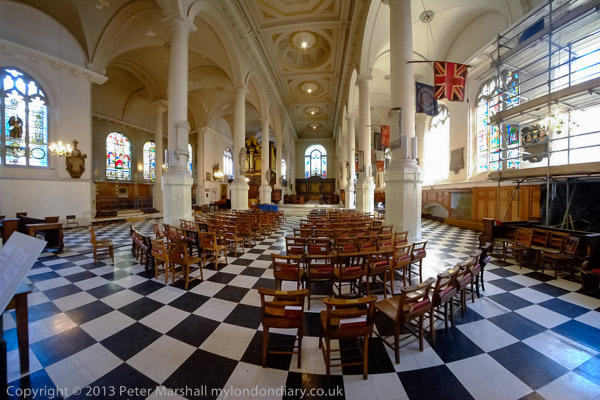
These two pictures inside Saint Sepulchre-Without-Newgate, taken from almost the same position, give a good idea of the relative views of the 14mm and 8.5mm lenses. I think had I taken the lower image with the Nikon 16mm semi-fisheye the plugin would have removed all curvature from the vertical pillars.
There are more examples in Christian Aid Circle the City, where you can also see that I had some problems in getting proper colour correction from the pictures taken outdoors in bright sun from the Fuji images. Although people often praise Fuji cameras for their colour I have more problems with this than when using Nikon. Perhaps this is a problem with Lightroom.
I do like using these two Fuji cameras, though from the reviews the Fuji XT1 might well suit me better. I’ll let you know more about that in a month or two. But the card problem with the XE1 really has me worried. Though I asked on a Fuji facebook page and I don’t think anyone else had experienced a similar problem. But I’ve only had to try to rescue files made on other cameras when I’ve deleted files or formatted cards in error, and have managed to get these back fully unless they have been overwritten.
______________________________________________________
My London Diary : Buildings of London : River Lea/Lee Valley : London’s Industrial Heritage
All photographs on this and my other sites, unless otherwise stated, are taken by and copyright of Peter Marshall, and are available for reproduction or can be bought as prints.
To order prints or reproduce images
________________________________________________________